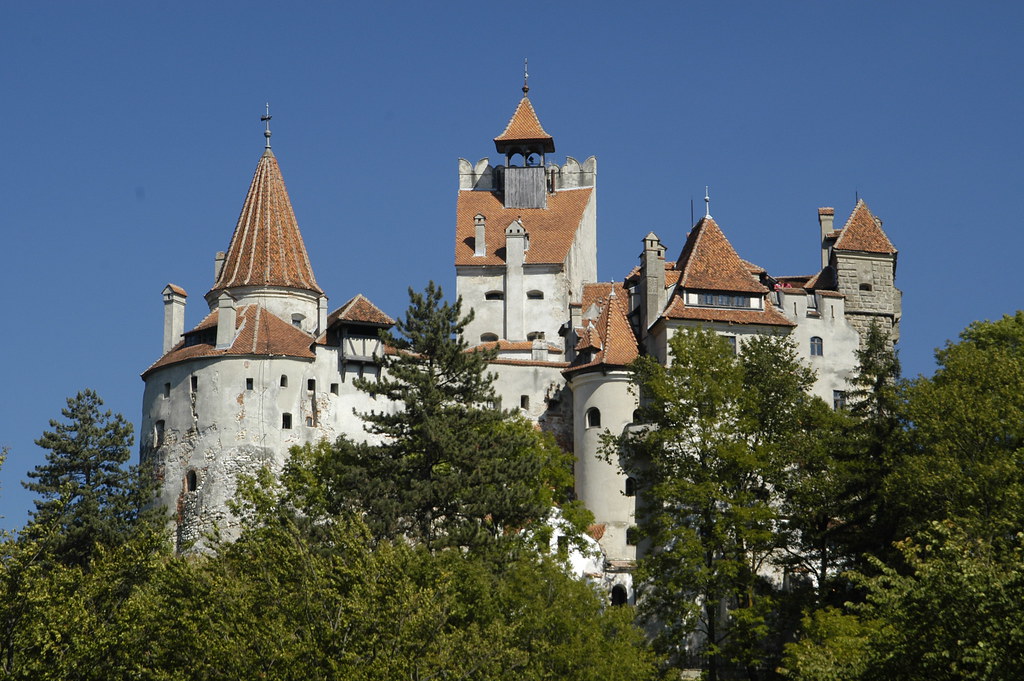A lot of tangential articles began to appear on social media recently, tying-in with the hype around the latest film adaption of Stephen King’s “It.” One article I noticed included a list of his major works, from the early days of his writing career to the present. It included “The Shining,” and rightly so; a very successful book (1977) and movie (1980) in its own right. The article mentioned that the Stanley Hotel inspired the setting for The Shining. I guess I knew this very real hotel influenced the fictional setting although I never thought about it much. Then I began to consider other possibly infamous, spooky places.
The Stanley Hotel

Anyone wanting to visit the Stanley Hotel could head over to Estes Park, Colorado (map) where it continues to operate today. The resort began in the early 20th Century, the creation of Freelan Oscar Stanley. He’d made his fortune on the east coast as the inventor of the Stanley Steamer, an early automobile powered by steam.
Stanley arrived in this beautiful Rocky Mountain valley suffering from what used to be called Consumption, now commonly called Tuberculosis. Fresh mountain air helped considerably with his condition and he vowed to return as often as he could. Eventually he built a luxury hotel with every amenity his High Society friends from the east would appreciate.
The Stanley lost a lot of its luster by the time Stephen King and his wife visited in the 1970’s. It was about to close for the season and the Kings were the only lodgers in an otherwise empty 140-room hotel. That night, King woke from a nightmare while staying in Room 217, and quickly outlined the plot for The Shining. The Stanley Hotel became the Overlook Hotel in his novel although Room 217 still figured prominently.
The Stanley did not have a haunted reputation during its first seventy years. Oddly, or perhaps suspiciously, so-called paranormal investigators discovered all sorts of spooky anomalies in the years after the The Shining appeared.
112 Ocean Avenue

All I need to say about 112 Ocean Avenue (map) is the city where it’s located and many readers will recognize the reference immediately: Amityville, New York. The Amityville Horror, published in 1977, told the story of the Lutz family who fled the house only four weeks after they moved in. The book — advertised as a “true story” — became a runaway bestseller and inspired a movie and various sequels.
The DeFeo family lived in this Long Island home for several years before the Lutz family moved there. One night in 1974, the eldest DeFeo child, Ronald Jr., murdered his family in this home. His parents and four siblings all died from gunshot wounds. Ronald went to prison where he still remains more than forty years later.
George and Kathleen Lutz purchased the home soon thereafter, well-aware of its history. They claimed that all sorts of evil, demonic things happened to them while they lived there. They fled, wrote their book, and made a pile of money. A falling out with their attorneys led to a string of lawsuits and accusations of fraud. One of the self-admitted conspirators claimed it was a hoax that they created as they drank several bottles of wine.
Since that time, the home has passed to several new owners, none of whom reported any unusual paranormal activities. One owner finally altered the exterior of the home and changed its address to 108 Ocean Avenue although people continue to visit. It attracted quite a bit of attention during its latest sale in November 2016.
Bran Castle

Where did Dracula live? In Transylvania, of course. The Irish writer Bram Stoker published Dracula, his most famous work in 1897. It spawned the entire Vampire genre of horror fiction that continues to remain popular today.
Most people probably know that the name of the novel’s title character came from Vlad the Impaler, a Prince of Wallachia. That region of Romania fell “between the Carpathians and the Danube River.” It did not include Transylvania. Dracula came from his surname, having been born the son of Vlad Dracul. He earned his ghastly Impaler title when he attacked a bunch of Saxon villages, marched the inhabitants back to Wallachia and impaled them on stakes.
Later, in 1462, he had no qualms about crossing into Ottoman territory and slaughtering several thousand more people there. Stories of his cruelty and butchery spread throughout Europe. Stoker read accounts centuries later and thought Dracula would be a great name for a bloodthirsty vampire.
One Romanian castle on the border between Wallachia and Transylvania gained a reputation for being Dracula’s abode. Bran Castle somehow claimed the title (map). Interestingly, Vlad never resided there. Sure, he passed it various times on his military excursions through the valley, although nothing more significant than that. Additionally, Bram Stoker probably wasn’t thinking of this castle specifically when he wrote Dracula. More likely, he used a composite of ideas. Nonetheless, Bran Castle somehow marketed itself successfully as a place that seemed like it should be Dracula’s castle. Good for them. Keep those tourists coming.
Bonus!
Bigfoot would also meet the definition of this article. However, I mentioned the most famous Bigfoot location, the spot of the infamous Patterson-Gimlin film, in Hairy Man.
I came up with a few other ideas too, enough for another article so stay tuned for Part II. Feel free to put ideas or suggestions in the comments and maybe I’ll continue with even more spooky places after that.

Leave a Reply